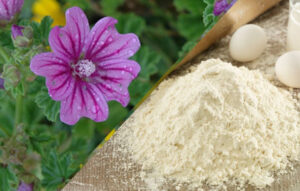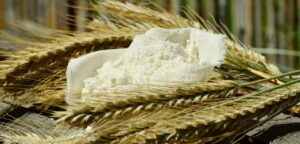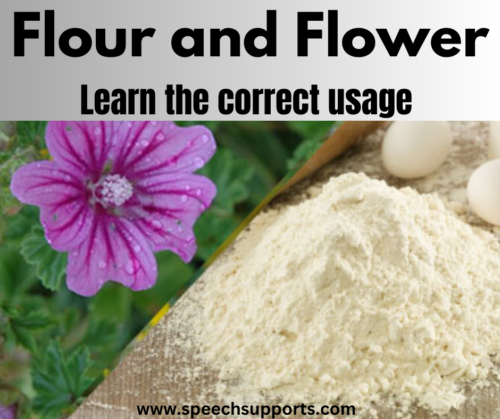Flour and flower are two words that sound alike but have vastly different meanings and uses in the English language. “Flour” is a powdery substance made from grinding grains, used in baking and cooking, while “flower” refers to the colorful and often fragrant part of a plant that produces seeds.
The similarity in pronunciation between these two words often leads to confusion, but understanding their distinct meanings is essential for clear communication.
Importance of knowing the difference of flour and flower for clear communication
Understanding the difference between flour and “flower” is crucial for clear communication in the English language.
Here are some key reasons why:
- Avoiding Confusion: These two words have completely different meanings. “Flour” refers to the powdery substance used in baking, while “flower” refers to the reproductive structure of a flowering plant. Using the correct term helps prevent misunderstandings.
- Culinary Accuracy: In cooking and baking, precision is essential. Using the right type of flour is critical for achieving the desired texture and flavor in recipes. Mistaking “flower” for “flour” in a recipe can lead to disastrous culinary outcomes.
- Professionalism in Writing: In professional settings such as business emails, reports, or academic papers, using the correct term demonstrates attention to detail and a strong command of the language. It reflects positively on the writer’s credibility.
- Avoiding Embarrassment: Using the wrong term, especially in public or formal situations, can lead to embarrassment. Imagine a chef mistakenly asking for “two cups of white flower” in a busy kitchen!
- Clarity in Gardening and Botany: For individuals interested in gardening or botany, knowing the difference is essential. Confusing the two could lead to misunderstandings about plant care or identification.
- Enhancing Reading Comprehension: When reading instructions, recipes, or any written material, correctly identifying flour vs flower ensures that the reader understands the content accurately.
- Facilitating Effective Teaching: For educators, particularly those teaching subjects like cooking, botany, or language arts, being able to clearly explain the distinction between these words is fundamental.
- International Communication: English is a global language, and many people around the world are learning it as a second language. Understanding the nuances of words like flour vs flower contributes to effective international communication.
- Preventing Errors in Legal and Official Documents: In legal and official documents, precision in language is of utmost importance. Misusing flour for “flower” or vice versa could potentially lead to confusion or legal complications.
- Cultural Sensitivity: In some cultures, certain types of flowers hold significant meaning or symbolism. Using the correct term is essential for respecting and understanding these cultural nuances.
Flour

Flour is a fine, powdery substance that is primarily made by grinding grains or other starchy foods. It is a fundamental ingredient in cooking and baking and serves various purposes in the culinary world. Flour provides structure, texture, and thickness to a wide range of dishes.
Common Uses of Flour:
- Baking: Flour is a key ingredient in baking, used in recipes for bread, cakes, cookies, pastries, and more. It provides the structure by forming a network when mixed with liquid and leavening agents like yeast or baking powder. Different types of flour are used for specific baking purposes, as detailed below.
- Thickening: Flour is employed as a thickening agent in sauces, gravies, and soups. When mixed with a liquid and heated, it forms a paste that thickens the mixture. This is particularly common in recipes like roux, where flour and fat are combined to make a thickening agent.
- Breading: Flour is often used as part of the breading process for frying foods. It helps the breading adhere to the food, creating a crispy outer layer when fried.
- Coating for Frying: Flour is used to coat foods like chicken, fish, or vegetables before frying. The flour coating helps protect the food from direct contact with hot oil and creates a crispy crust.
- Pasta and Noodle Making: In the production of pasta and noodles, various types of flour, such as semolina flour, are used to create the dough.
Types of Flour:
- All-Purpose Flour: This is the most commonly used type of flour in many households. It is versatile and suitable for a wide range of baking and cooking applications, including bread, cakes, cookies, and sauces.
- Whole Wheat Flour: Whole wheat flour is made from the entire wheat kernel, including the bran, germ, and endosperm. It is higher in fiber and nutrients compared to all-purpose flour and is often used for making whole-grain bread and baked goods.
- Cake Flour: Cake flour is finely milled and has a lower protein content than all-purpose flour. It is ideal for making delicate, tender cakes and pastries. The lower protein content results in a finer crumb texture.
- Bread Flour: Bread flour has a higher protein content than all-purpose flour, making it suitable for yeast-based bread recipes. The extra protein helps develop gluten, giving bread its characteristic chewy texture.
- Pastry Flour: Pastry flour falls between all-purpose and cake flour in terms of protein content. It’s suitable for making pastries and pie crusts, providing a balance between tenderness and structure.
- Semolina Flour: Semolina is often used to make pasta and noodles. It’s coarser than all-purpose flour and is made from durum wheat, giving pasta a firmer texture.
- Self-Rising Flour: This is all-purpose flour that has baking powder and salt already added. It’s convenient for recipes like biscuits and pancakes but should not be substituted for other flours without adjusting the recipe.
Understanding the differences between these types of flour and their specific uses is essential for successful cooking and baking, as it ensures that you achieve the desired texture and flavor in your dishes.
Flower

Flower has multiple meanings, and its usage varies depending on the context. Here are some of the different meanings and contexts in which “flower” is used:
- Botanical Context:
-
- Flower (Botanically): In botany, a flower is the reproductive structure of flowering plants (angiosperms). It typically consists of petals, sepals, stamens (male reproductive parts), and a pistil (female reproductive part). The primary function of a flower is to facilitate pollination and the production of seeds.
- Gardening and Horticulture:
-
- Flower (Garden): In gardening and horticulture, a flower refers to the colorful, often fragrant, and ornamental part of a plant that is cultivated for its beauty. Flowers are grown in gardens, parks, and as decorative elements in various landscaping contexts.
- Symbolic and Cultural Context:
-
- Symbolism: Flowers are often used as symbols in various cultures. Different types of flowers can represent specific emotions or concepts. For example, a red rose is often associated with love and passion, while a white lily can symbolize purity or sympathy. The language of flowers, known as “floriography,” has been used historically to convey messages and sentiments through the choice and arrangement of flowers.
- Occasions and Gifts:
-
- Gifts and Bouquets: Flowers are commonly given as gifts on special occasions such as birthdays, anniversaries, and weddings. Bouquets of flowers, especially roses, are a traditional expression of affection and love.
- Art and Literature:
-
- Metaphorical Usage: In art and literature, “flower” is often used metaphorically to describe the peak or prime of something. For example, someone in their prime might be described as “in the flower of their youth.”
- Culinary Context:
-
- Edible Flowers: Some flowers are edible and used in culinary applications as garnishes or ingredients in salads, desserts, and beverages. Examples of edible flowers include nasturtiums and violets.
- Environmental and Conservation Context:
-
- Wildflowers: In the context of the environment and conservation, “wildflowers” refer to native or naturalized flowering plants that grow in the wild. Wildflowers are important for supporting pollinators and maintaining biodiversity.
- Scientific and Medicinal Context:
-
- Flower Remedies: In alternative medicine, flower essences or remedies are used for their purported healing properties. These remedies are often made by infusing the essence of flowers in water and are used for emotional and psychological well-being.
Understanding the diverse meanings and uses of the word “flower” is essential for effective communication, as the context in which it is used can greatly influence its interpretation.
Why “flour” and “flower” are often confused in writing and speech
Flour and flower are often confused in writing and speech due to a combination of factors, including their homophonic nature, visual similarity, and the context in which they are used.
Here are some reasons why these two words can be easily mixed up:
- Homophonic Nature: The most significant reason for the confusion is that “flour” and “flower” are homophones, which means they are pronounced the same way but have different meanings and spellings. Homophones are a common source of confusion in the English language because they rely solely on auditory cues.
- Visual Similarity: While they may not look similar when written separately, when quickly handwritten or typed, the visual similarity between flour vs flower can lead to confusion, especially if the writer or reader is not paying close attention.
- Phonetic Challenges: The pronunciation of flour and flower can vary slightly among different English accents. This variation can make it even more challenging for non-native speakers or those learning the language to distinguish between the two.
- Contextual Ambiguity: The words flour vs flower are often used in different contexts but sometimes can be found together in the same context, creating potential for confusion. For instance, a recipe might call for “2 cups of flour” and “a bouquet of flowers” in the same set of instructions.
- Cognitive Processing: In the rush of speech or writing, our brains can occasionally replace one word with the other, as both words are stored in our mental lexicon and share a common pronunciation. This is a form of cognitive slip or a “tip-of-the-tongue” phenomenon.
- Inattentiveness: Careless proofreading and editing can contribute to the confusion. People might overlook errors when reading their own writing because they anticipate the intended word and fail to notice the mistake.
- Frequency of Use: Depending on a person’s interests and activities, they may encounter one of these words more frequently than the other. This lack of exposure to one of the words can result in a less firm grasp of its correct usage.
- Lack of Word Awareness: Some individuals may not have a strong awareness of words and their specific meanings, which can make it more challenging to distinguish between homophones like “flour” and “flower.”
To avoid this confusion, it’s essential to be attentive to the context, practice good proofreading and editing, and learn to recognize the different meanings and usage of flour and flower. Familiarity with homophones and the ability to use them correctly in context come with practice and experience in the English language.
Common scenarios in which people mix up these words
Flour” and “flower” are homophones, meaning they sound the same but have different meanings, which can lead to confusion in various scenarios.
Common scenarios in which people mix up these words include:
- Baking and Cooking: Given that “flour” is a common ingredient in baking, people often mix up “flour” and “flower” when following recipes. Misusing these words can lead to confusion in the kitchen and affect the outcome of dishes.
- Spelling and Typing Errors: In written communication, such as emails, messages, or reports, people may accidentally type “flower” instead of “flour” and vice versa due to the phonetic similarity. Spellcheckers may not always catch these errors, particularly if both words are valid in the given context.
- Verbal Communication: When speaking, especially in fast or casual conversation, people might unintentionally substitute “flower” for “flour” or vice versa, as the two words are pronounced the same way. This can lead to misunderstandings if the listener doesn’t deduce the correct meaning from the context.
- Foreign Language Speakers: Non-native English speakers may be more prone to mixing up these words because they may not be as familiar with English homophones and the subtle differences in pronunciation.
- Text Messages and Social Media: In informal written communication, such as text messages, social media posts, or comments, people might not pay as much attention to spelling and may inadvertently use “flower” when they meant “flour” or vice versa.
- Educational and Professional Settings: In academic or professional settings, using the wrong word can have consequences. For example, a student submitting a research paper with the word “flower” instead of “flour” in a botanical context could affect the paper’s credibility.
- Customer Orders: In businesses like bakeries or florists, order errors can occur if someone writes down or takes an order over the phone incorrectly. Confusing “flower” and “flour” can lead to incorrect deliveries.
To avoid these mix-ups, it’s important to proofread written content, double-check recipes, and clarify your meaning in verbal communication when using these words. Additionally, being aware of the context and the intended meaning of the word can help prevent misunderstandings.
Tips and strategies for distinguishing between flour and flower in both writing and speech.

Distinguishing between “flour” and “flower” in writing and speech is important for clear communication. Here are some tips and strategies to help you avoid mixing up these homophones:
In Writing:
- Proofread Carefully: Always proofread your written content, whether it’s an email, document, or social media post. Look for instances where “flour” or “flower” may have been used incorrectly.
- Use Spellcheck: Most word processors and text editors have built-in spellcheckers. While they may not catch homophone errors, they can help you spot obvious spelling mistakes.
- Be Mindful of Context: Consider the context of your writing. If you’re discussing cooking or baking, it’s likely “flour” is the correct term. If you’re writing about gardens or bouquets, “flower” is the appropriate word.
- Double-Check Recipes: When following a recipe, pay close attention to the ingredient list. Make sure you use “flour” for cooking and baking instructions and “flower” only for garnish or decoration, if applicable.
- Homophone Awareness: Develop an awareness of homophones in English. Understanding that “flour” and “flower” sound the same but have different meanings can help you be more vigilant.
In Speech:
- Enunciate Clearly: When speaking, be sure to enunciate your words clearly. Pay particular attention to the “l” sound in “flour” and the “w” sound in “flower.”
- Use Gestures: In situations where you’re not sure if the listener understood you correctly, you can use hand gestures to indicate the context. For example, when saying “flour,” you can mimic measuring and mixing in the air with your hands. For “flower,” you can make a gesture like smelling a flower.
- Context Clues: Provide additional context when necessary. For instance, if you’re talking about baking, you can say, “I need one cup of ‘flour,’ like what you use in cakes and bread.”
- Self-Monitor: While speaking, be mindful of the words you use. If you catch yourself saying the wrong word, correct it immediately. For example, if you say “flower,” follow it up with, “I mean ‘flour’ for the recipe.”
- Practice and Listen: Practicing proper pronunciation and listening to native speakers can help you improve your spoken English and reduce the chances of using the wrong word inadvertently.
Remember that everyone makes mistakes, and even native speakers occasionally mix up homophones. However, with practice and attention to detail, you can reduce the frequency of these errors and enhance your clarity in both writing and speech.
Common Mistakes involving “flour” and “flower and How to Avoid Them
Common mistakes involving “flour” and “flower” typically revolve around confusion in written and spoken communication. Here are some common mistakes and how to avoid them:
Confusing Spellings in Writing:
- Mistake: Writing “flower” instead of “flour” or vice versa due to similar spellings.
- How to Avoid: Double-check your spelling in written content. Be mindful of the context in which you are using the word and choose the correct one accordingly.
Recipe Errors:
- Mistake: Using “flower” instead of “flour” or vice versa in recipes.
- How to Avoid: Carefully read and follow recipes, paying close attention to the ingredient list. Be certain that you use “flour” when a recipe calls for it and “flower” only when it’s meant for garnish or decoration.
Spelling and Grammar Checkers:
- Mistake: Relying solely on spelling and grammar checkers, which may not catch homophone errors.
- How to Avoid: While using spellcheckers, remember to proofread your content for context. Do not solely rely on automated tools to catch homophone mistakes.
Lack of Context in Speech:
- Mistake: Using “flour” or “flower” in spoken language without providing enough context, leading to confusion.
- How to Avoid: When speaking, clarify the context or use gestures if necessary. For example, specify if you’re discussing cooking (“flour”) or a bouquet (“flower”).
Rapid Speech:
- Mistake: Speaking too quickly can lead to the incorrect use of “flour” or “flower.”
- How to Avoid: Speak slowly and enunciate clearly, paying attention to the distinct “l” sound in “flour” and the “w” sound in “flower.”
Lack of Awareness of Homophones:
- Mistake: Not recognizing that “flour” and “flower” are homophones, causing unintentional mix-ups.
- How to Avoid: Develop an awareness of homophones in English and specifically identify “flour” and “flower” as words that sound the same but have different meanings.
Carelessness:
- Mistake: Making mistakes due to carelessness or not proofreading written content.
- How to Avoid: Take your time when writing and reviewing your work. Proofreading is essential for catching homophone errors.
Mispronunciation:
- Mistake: Mispronouncing “flour” or “flower,” which can lead to misunderstandings.
- How to Avoid: Practice proper pronunciation and enunciation, emphasizing the differences in sound between the two words.
Overreliance on Autocorrect:
- Mistake: Relying on autocorrect on smartphones, which may auto-correct to the wrong word.
- How to Avoid: Be cautious with autocorrect and review your messages before sending them, especially in contexts where “flour” and “flower” are used.
By being mindful of the differences in meaning, practicing correct pronunciation, and paying attention to context, you can avoid these common mistakes and communicate more effectively when using flour and flower.
Conclusion
Flour and flower are often confused in writing and speech due to a combination of factors, including their homophonic nature, visual similarity, and the context in which they are used.
To avoid this confusion, it’s essential to be attentive to the context, practice good proofreading and editing, and learn to recognize the different meanings and usage of flour and flower. Familiarity with homophones and the ability to use them correctly in context come with practice and experience in the English language.

